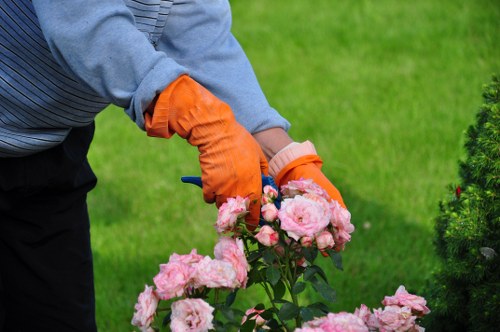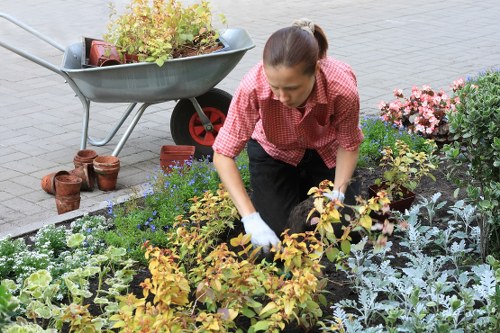Expert Hedge Trimming Services in Greenwich
Introduction to Hedge Trimming

Maintaining a well-manicured hedge is essential for enhancing the aesthetic appeal and value of your property. In Greenwich, hedge trimming is not just about keeping your greenery in shape; it’s about creating a beautiful landscape that complements your home or business.
Regular hedge trimming promotes healthy growth, prevents overgrowth, and ensures that your hedges remain a focal point of your outdoor space. Whether you have a small garden or a large estate, professional hedge trimming can make a significant difference.
Greenwich residents understand the importance of professional landscaping services. With the right approach, your hedges can become a stunning backdrop for your outdoor activities and gatherings.
Why Choose Professional Hedge Trimming?

Professional hedge trimming offers numerous benefits compared to DIY methods. Trained arborists and landscapers have the expertise to assess the health of your hedges and determine the best trimming techniques to promote growth and maintain shape.
Using the right tools and techniques, professionals can achieve precise cuts that minimize stress on the plants. This leads to healthier hedges that are more resilient to pests and diseases.
Moreover, professional hedge trimming saves you time and effort. Instead of spending hours trying to trim your hedges, you can rely on experts to deliver exceptional results efficiently.
The Hedge Trimming Process
Assessment and Planning
The first step in professional hedge trimming is a thorough assessment of your hedges. Experts evaluate the current state, identify any health issues, and determine the appropriate trimming strategy.
This planning phase ensures that the trimming process aligns with your aesthetic preferences and the natural growth patterns of your hedges. It also helps in identifying any barriers or obstacles that might affect the trimming process.
Proper planning is crucial for achieving balanced and evenly trimmed hedges that enhance the overall look of your property.
Choosing the Right Tools

Having the right tools is essential for effective hedge trimming. Professionals use a variety of equipment, including hedge trimmers, shears, and loppers, to achieve clean and precise cuts.
Each tool serves a specific purpose, from shaping the overall structure to fine-tuning the details. Investing in quality tools ensures that your hedges are trimmed efficiently and with minimal damage.
Regular maintenance of these tools is also important to maintain their effectiveness and longevity.
Techniques for Healthy Hedges

Proper trimming techniques are vital for the health and longevity of your hedges. Over-trimming or incorrect cutting can lead to stunted growth, disease, and even death of the plants.
Experts focus on selective trimming, which involves removing only the necessary parts to maintain shape and promote airflow. This reduces the risk of fungal infections and encourages robust growth.
Additionally, shaping techniques are employed to ensure that the hedges have a uniform appearance and fit well within the landscape design of your property.
Seasonal Hedge Trimming Tips
Spring Trimming
Spring is an ideal time for hedge trimming as it encourages new growth and helps to control the size of your hedges after the winter dormancy period.
Trimming in spring also allows you to shape your hedges before the growing season begins, ensuring they stay well-maintained throughout the year.
Early trimming can also help in identifying any damage or disease that may have occurred during the colder months.
Summer Maintenance
During the summer, regular maintenance trimming can help manage the growth and prevent hedges from becoming overgrown.
It's important to trim hedges in the cooler parts of the day to reduce stress on the plants and minimize water loss.
Summer trimming also helps improve air circulation, reducing the risk of fungal diseases and promoting healthier growth.
Autumn and Winter Care
In autumn, hedge trimming focuses on preparing the plants for the winter months. This includes removing any weak or damaged branches that could be more susceptible to cold weather.
Winter trimming is usually minimal, as hedges are less active during this period. However, light pruning can help maintain shape and remove any last-minute overgrowth.
Proper autumn and winter trimming ensure that your hedges remain healthy and resilient, ready to thrive in the spring.
Types of Hedges and Their Trimming Needs
Coniferous Hedges
Coniferous hedges, such as boxwood and pine, require specific trimming techniques to maintain their dense and pillar-like shape.
Regular trimming prevents them from becoming too wild and ensures that they retain their desired form.
Thinning cuts are often used to allow light and air to penetrate the foliage, promoting overall health.
Deciduous Hedges
Deciduous hedges, like laurel and beech, shed their leaves annually and require seasonal trimming to shape and stimulate new growth.
These hedges benefit from a more flexible trimming schedule, adapting to their growth patterns throughout the year.
Proper maintenance keeps them vibrant and lush, enhancing the visual appeal of your garden.
Flowering Hedges
Flowering hedges, such as forsythia and hydrangea, not only provide greenery but also add bursts of color to your landscape.
Trimming these hedges requires careful timing to avoid removing budding flowers or inflorescences.
Selective trimming ensures that you enjoy both the beauty of the blooms and the structured shape of the hedge.
Benefits of Well-Trained Hedges
- Enhanced Curb Appeal: Neatly trimmed hedges create an inviting and attractive first impression.
- Increased Property Value: Beautiful landscaping, including well-maintained hedges, can significantly boost your property’s market value.
- Privacy and Security: Dense hedges provide natural barriers, ensuring privacy and enhanced security for your home.
- Environmental Advantages: Hedges act as windbreaks, reduce noise pollution, and support local wildlife by providing habitats.
- Healthier Plants: Regular trimming promotes robust growth, prevents diseases, and maintains the overall health of your hedges.
Choosing the Right Hedge Trimming Service in Greenwich

With numerous hedge trimming services available in Greenwich, selecting the right one can be challenging. Here are some factors to consider:
- Experience and Expertise: Look for professionals with a proven track record and extensive experience in hedge trimming.
- Reputation: Check reviews and testimonials to gauge the quality of their services.
- Services Offered: Ensure that the company provides comprehensive services, including assessment, trimming, and maintenance.
- Pricing: Compare quotes from different providers to find competitive and transparent pricing.
- Insurance and Licensing: Verify that the company is properly insured and licensed to protect against any potential liabilities.
Choosing the right hedge trimming service ensures that your hedges receive the best care and attention, resulting in a beautiful and healthy landscape.
Maintaining Your Hedges Between Professional Trims
Regular Monitoring
Even with professional hedge trimming, regular monitoring is essential to maintain the desired shape and health of your hedges.
Keep an eye out for any signs of overgrowth, pests, or diseases, and address them promptly to prevent further issues.
Simple upkeep tasks, like removing dead leaves and branches, can make a significant difference in the long-term health of your hedges.
Proper Watering and Feeding
Adequate watering and feeding are crucial for the vitality of your hedges. Ensure they receive the right amount of water, especially during dry spells.
Fertilizing your hedges with appropriate nutrients supports healthy growth and strengthens their resistance to diseases.
Consult with a professional to determine the best watering and feeding schedule for your specific type of hedges.
Pruning Techniques
Adopting correct pruning techniques helps maintain the structure and appearance of your hedges. Avoid cutting too much at once, as this can stress the plants.
Instead, perform light trims regularly to keep the hedges in good shape and encourage dense growth.
Following best practices in pruning ensures that your hedges remain healthy and aesthetically pleasing.
Common Hedge Trimming Mistakes to Avoid
- Over-Trimming: Removing too much foliage can weaken the hedge and make it susceptible to disease.
- Improper Timing: Trimming hedges at the wrong time of year can disrupt their growth cycle and reduce their vitality.
- Using the Wrong Tools: Inadequate or dull tools can cause jagged cuts, leading to damage and slow healing.
- Ignoring Plant Health: Failing to assess the health of your hedges before trimming can result in exacerbating existing problems.
- Neglecting Maintenance: Infrequent trimming can lead to unruly growth that is harder to manage over time.
Eco-Friendly Hedge Trimming Practices
Using Sustainable Tools
Opt for eco-friendly hedge trimming tools that are energy-efficient and reduce environmental impact. Battery-powered or manual tools are preferable to gas-powered options for lower emissions.
Regularly maintaining your tools ensures they operate efficiently, further minimizing your carbon footprint.
Additionally, consider tools made from sustainable materials to support environmentally responsible landscaping.
Waste Management
Properly disposing of hedge trimmings is vital for environmental conservation. Composting green waste is an excellent way to recycle nutrients back into the soil.
Many professional services offer green waste disposal as part of their package, ensuring that the trimming byproducts are managed responsibly.
Alternatively, you can arrange for local green waste collection services to handle the disposal of your hedge trimmings.
Water Conservation
Efficient watering practices help conserve water while keeping your hedges healthy. Use drip irrigation systems or soaker hoses to deliver water directly to the roots, reducing evaporation and runoff.
Water your hedges during the early morning or late evening to minimize water loss and maximize absorption.
Implementing water-saving techniques contributes to a sustainable and eco-friendly landscape.
Cost of Hedge Trimming in Greenwich
The cost of hedge trimming in Greenwich varies based on several factors, including the size of the hedges, the type of plants, the extent of trimming required, and the frequency of service.
On average, homeowners can expect to pay between $100 and $300 for basic hedge trimming services. Larger or more complex hedges may incur higher costs due to the additional labor and expertise required.
It's advisable to obtain quotes from multiple service providers to ensure you receive competitive pricing and value for your investment.
- Size of the Hedge: Larger hedges require more time and effort, increasing the overall cost.
- Type of Plant: Some plants may require specialized trimming techniques, affecting the price.
- Accessibility: Hedges that are difficult to access or located in hard-to-reach areas may incur additional charges.
- Frequency of Service: Regular maintenance contracts can offer discounts and better pricing compared to one-time services.
Understanding the factors that influence the cost helps you budget appropriately and choose the best service for your needs.
Conclusion
Hedge trimming in Greenwich is a vital aspect of maintaining a beautiful and healthy landscape. Professional services not only enhance the aesthetic appeal of your property but also ensure the longevity and vitality of your hedges.
By choosing experienced and reputable hedge trimming experts, you can enjoy the benefits of well-maintained hedges without the stress and effort of doing it yourself.
Investing in regular hedge trimming is an investment in the beauty, value, and sustainability of your outdoor space.
Contact us today to book your professional hedge trimming service and transform your Greenwich property into a stunning green oasis.
Get In Touch With Us.
Please fill out the form below to send us an email and we will get back to you as soon as possible.